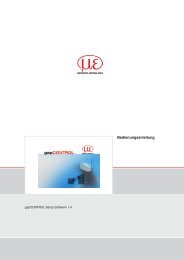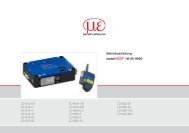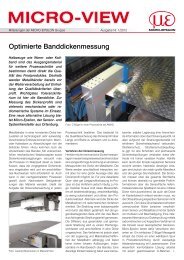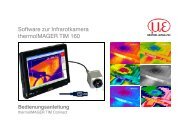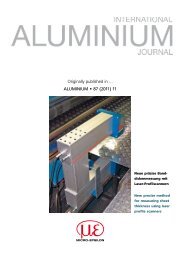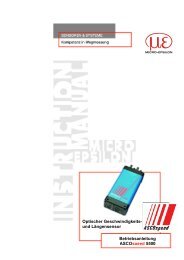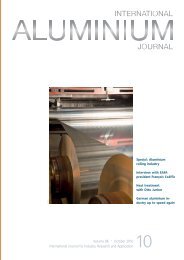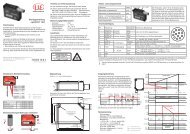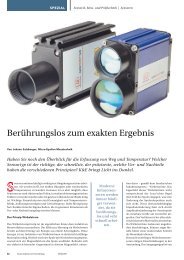Hochgeschwindigkeitsschneidanlagen erfordern anspruchsvolle ...
Hochgeschwindigkeitsschneidanlagen erfordern anspruchsvolle ...
Hochgeschwindigkeitsschneidanlagen erfordern anspruchsvolle ...
Sie wollen auch ein ePaper? Erhöhen Sie die Reichweite Ihrer Titel.
YUMPU macht aus Druck-PDFs automatisch weboptimierte ePaper, die Google liebt.
A L U M I N I U M w a l z I N D U S T R i e<br />
Zusammenfassung<br />
Gewichtsverringerung und Miniaturisierung<br />
führen unweigerlich zu einem erhöhten Bedarf<br />
an dünneren Bändern. Gleichzeitig führt<br />
die Tendenz zu großen Bundgewichten und<br />
geringeren Banddicken zu erhöhten Laufzeiten<br />
auf den Anlagen.<br />
Danieli Fröhling stellt sich diesen Marktanforderungen<br />
mit der Entwicklung und Fertigung<br />
von <strong>Hochgeschwindigkeitsschneidanlagen</strong>.<br />
Das erfordert jedoch eine Optimierung<br />
der Kreismesserscheren, deren konstruktiver<br />
Aufbau, die Steifigkeit des gesamten Messerwellensystems<br />
sowie die FEM-Analyse bis<br />
hin zur Schnittspaltwahl und Eintauchtiefe die<br />
Qualität des Schneidprozesses bestimmen.<br />
Die Entwicklung von CNC-gesteuerten<br />
Längsteil- und Besäumscheren ist eine der<br />
wichtigsten Innovationen in der 65-jährigen<br />
Tradition des Unternehmens.<br />
Doch nicht nur der Schnitt bestimmt die<br />
Qualität des fertigen Coils, sondern auch ein<br />
exaktes Wickelbild gehört zu den Kundenforderungen.<br />
Hier hat Fröhling mit der Vakuumtechnologie<br />
als Bremsgerüst einen Meilenstein<br />
gesetzt und kann bereits auf den Einsatz<br />
von über 30 Vakuumrollen weltweit bei führenden<br />
Bandproduzenten verweisen.<br />
Die technologischen Schwerpunktgruppen<br />
Schneiden mit Kreismessern, Bremsen und<br />
Wickeln <strong>erfordern</strong> für ein optimales Zusammenspiel<br />
eine leistungsfähige Echtzeiterfassung<br />
des jeweiligen Betriebszustandes. Dazu<br />
gehört eine hochpräzise Geschwindigkeitserfassung<br />
sowie optionale Dickenmessung des<br />
Bandes.<br />
Durch seine berührungsfreie Arbeitsweise<br />
und leistungsfähige Interfacemöglichkeit findet<br />
das ASCOspeed bevorzugt Einsatz als<br />
Geschwindigkeitsmaster in Bandanlagen, liefert<br />
die Information für die Synchronisation<br />
der Messerwelle sowie über die momentane<br />
Bandlänge und kann des weiteren zur Schlingengrubenregelung<br />
eingesetzt werden.<br />
Durch ihre Qualität und Leistungsfähigkeit<br />
erfreuen sich Schneidanlagen von Danieli<br />
Fröhling, auch dank der genutzten, hochpräzisen<br />
Messtechnik von Micro-Epsilon, weltweit<br />
großer Beliebtheit.<br />
Autoren<br />
Dipl.-Ing. Detlef Neumann ist Vize-Präsident und<br />
Vertriebsleiter der Josef Fröhling GmbH & Co. KG,<br />
ein Unternehmen der Danieli-Gruppe.<br />
Dr. Klaus Christofori ist als Produktmanager innerhalb<br />
der Micro-Epsilon-Gruppe für die Geschwindigkeitsmesstechnik<br />
verantwortlich.<br />
Abb. 7: ASCOspeed-Installation an Hochgeschwindigkeitsbesäumschere Nanshan<br />
Fig. 7: ASCOspeed installation at the Nanshan 3 high-speed trimming shear<br />
the reference is provided by the structure of<br />
the silicon receiver. This ensures a high degree<br />
of precision and long-term stability.<br />
Thanks to the fact that it operates without<br />
any contact and provides an opportunity to<br />
have a powerful interface, the ASCOspeed is<br />
used preferentially as the speed master in strip<br />
plants (Fig. 6). The device carries out measurements<br />
non-contact from a distance of<br />
300 mm and is thus not too close to the strip.<br />
Non-contact also means inertia-free – and this<br />
already indicates the benefit over an incremental<br />
mechanical measurement via deflection<br />
rolls, which always results in slip depending<br />
on the mass or the wrap-around.<br />
In slitters (Fig. 1), the ASCOspeed 5500<br />
has replaced the rotary encoder on the deflection<br />
roll for regulating the knife shaft and<br />
controlling the coil computer (Fig. 5) and provides<br />
exact and steady measurements for the<br />
widest possible range of strip thicknesses despite<br />
fluctuations in the strip speed and different<br />
surface finishes, even reflective surfaces.<br />
The exact rotating speed of the knife shaft<br />
is responsible for the high quality of the cut<br />
edge and the long service lives of the knives.<br />
Measuring the strip speed precisely and directly<br />
is a prerequisite for this.<br />
An interesting solution is the operation of<br />
two units as a slack-loop pit for control purposes.<br />
The actual length of the loop in the pit<br />
is the difference between the lengths of strip<br />
that have entered or exited the pit (Fig. 4).<br />
This method of measurement is often ben-<br />
eficial compared with direct measurement of<br />
the loop using laser distance sensors because<br />
oscillations in the strip loop can quickly create<br />
a problem with the laser distance measurements.<br />
The processing of soft strip is particularly<br />
demanding because the strip has to be<br />
coiled using as little tension as possible; this<br />
is achieved using appropriate braking stands.<br />
The ASCOspeed provides an exact measure<br />
of the strip speed.<br />
With edge-trimming lines, exact strip speed<br />
allows the trimming to be optimised and ensures<br />
the scrap produced can be removed<br />
without difficulty. Here, the measurement<br />
technology (Fig. 7) plays a key role in ensuring<br />
that the lines operate smoothly at high working<br />
speeds up to 1,800 m/min and at the same<br />
time satisfy the high quality demands with respect<br />
to cutting and coiling.<br />
Recently, laser transit-time sensors have<br />
been used increasingly for delivering and<br />
removing the coils; these determine the position<br />
of the coil with millimetre precision or<br />
can measure the coil diameter directly. The<br />
ILR1182 from Micro-Epsilon has proven its<br />
worth here.<br />
Summary<br />
Weight reduction and miniaturisation are inevitably<br />
leading to greater demand for thin<br />
strip. At the same time, the trend towards<br />
heavier coils and thinner strip is leading to<br />
increased strip-processing times.<br />
44 ALUMINIUM · 11/2013



